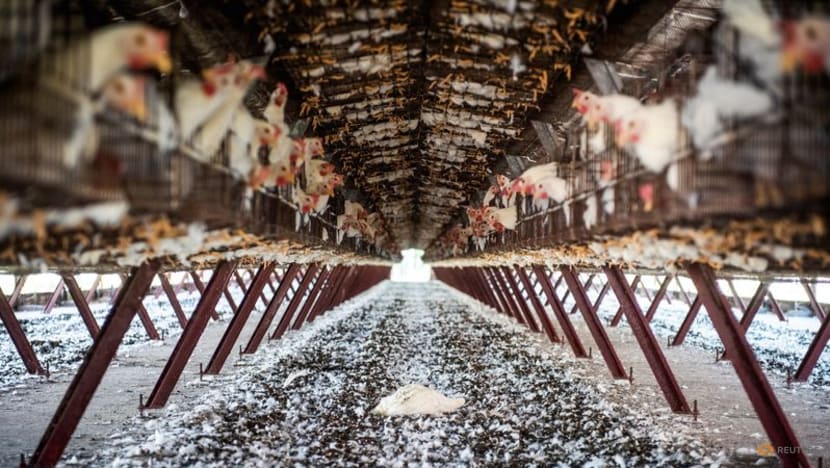Why bird flu in mammals sparks fear of the virus spreading in humans

An avian influenza - bird flu - outbreak with the H5N1 strain that began in 2020 has hit record levels, affecting millions of animals.
As the virus mutates genetically and spreads geographically, the normal ebb and flow of infection has given way to a persistently elevated level in wild birds.
They are spreading the highly contagious pathogen to domesticated poultry and a rising number of mammals, including badgers, bears, ferrets, pigs and raccoons - as well as a handful of people.
Though the virus has been around for decades, there are no signs of it having made the jump to human-to-human transmission. Still, the possibility exists that it could further evolve to cause catastrophic outbreaks in people - just as the world is moving beyond the worst of the COVID-19 pandemic.
HOW WIDESPREAD IS BIRD FLU?
Avian influenza in the US alone has affected nearly 60 million birds - including wildlife, commercial poultry and backyard flocks - since January 2022, according to the Centers for Disease Control and Prevention (CDC).
Also read:
That is on top of the 50 million birds destroyed in 36 European countries between October 2021 and September 2022. And it is not just birds.
In the UK, there have been 10 reports of infections in non-avian wildlife since the start of 2022, including in red foxes, Eurasian otters and harbour seals.
DOES BIRD FLU POSE A RISK TO HUMANS?
From 2020 through 2022, there were only nine confirmed human cases, including one in the US and one in the UK, according to the World Health Organization (WHO) - one case was reported in Ecuador in January this year and another in Cambodia in February.
Most often they involved a person who was in direct contact with sick birds. The viruses currently circulating do not have genetic changes that have been previously tied to infecting people more easily or causing severe illness, according to the CDC.
For example, they cannot bind easily to human respiratory tract receptors. Even in an outbreak last year at a Spanish mink farm, where more than 50,000 animals were culled, there was no sign of infection among nearly a dozen workers.
An expert report published by the European Food Safety Authority in January put the risk for the general population at low, as has the WHO, while urging continued close monitoring.
WHAT IS THE WORRY THEN?
The fear is the flu strain found in poultry could recombine with one that circulates in humans, resulting in a new version that transmits easily from person-to-person.
While there is no evidence of that happening, there are signs that bird flu may have begun to spread in other mammals.
A report following the mink farm outbreak cited evidence suggesting the animals could serve as a potential “mixing vessel” for interspecies transmission.
Early this year, more than 500 sea lions in Peru succumbed to the infection, another sign the virus could be circulating more easily among mammals. The rising rates in animals can translate to more people getting infected.
While human cases are still rare today, the death rate among those who had it in the past is sobering. Of the 868 people infected from 2003 through 2019, 457 of them died. Because infections often are not caught until the patient is clearly sick, however, milder cases may be missed - skewing the overall mortality rate.
WHAT ARE THE SYMPTOMS?
In birds, they can range from no discernible illness in ducks to multiple-organ failure and 100 per cent mortality within days for chickens.
Once any bird within a domesticated flock tests positive, the entire group is quickly culled - killed - to halt the spread of the virus. Nearby flocks are closely monitored. Infections in mammals have yielded some unexpected symptoms.
Three grizzly bears in Montana were euthanised last year after they were found disoriented and going blind. Tests subsequently showed they were infected with bird flu. The sea lions were convulsing and struggling to swim. The minks suffered loss of appetite, depression, bloody snouts and neurological issues like lack of coordination, trouble walking, and tremors.
In humans, H5N1 has caused symptoms ranging from mild eye and respiratory infections to severe pneumonia.
IS THE THREAT RISING?
Avian influenza has been circulating for more than a century - it was first described as “fowl plague” in northern Italy in 1878. But it was the discovery in 1996 of a highly pathogenic H5N1 strain among geese being bred on a farm in southern China that created serious, sustained alarm.
While today’s outbreaks remain primarily an animal health issue, the CDC said it is closely monitoring the situation, preparing for future threats and implementing prevention measures - including work on a potential vaccination.
Medical advances like antibiotics, antivirals, vaccines and other tools to control outbreaks reduce the danger, though it is critical to spot and stop human outbreaks as soon as possible.
WHAT ARE THE RAMIFICATIONS?
The impact is already clear in grocery stores.
In the US, the cost of a dozen eggs - when you can find them - has more than doubled over the past year to an average of US$4.82 in January, more than 450g of pork chops or ground beef.
The financial hit also applies to chicken and turkey producers. As of February, the US government had spent about US$661 million for clean up and to compensate farmers in the current outbreak.
A 2015 outbreak in the US, in which fewer birds were killed, led to more than US$3.3 billion in losses, according to one estimate. The spread also could add impetus to calls for less intensive livestock production and pose a danger to wildlife conservation efforts.













